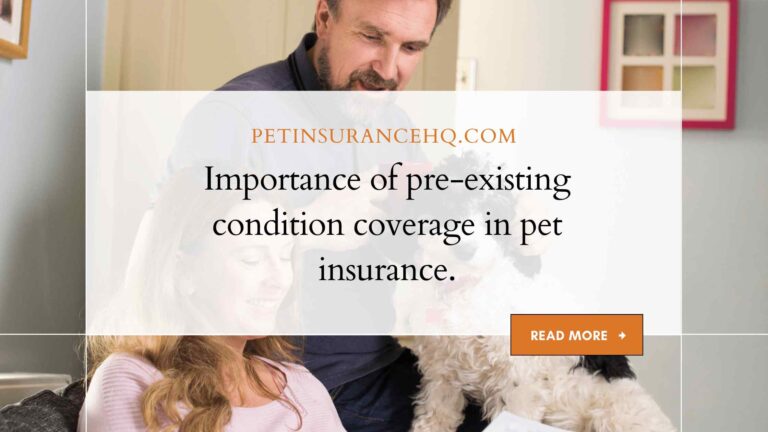How to Choose the Right Coverage Limits for Your Pet Insurance Policy
Do you love your furry friend more than life itself? Of course, you do! But have you thought about what would happen if they were to get sick or injured? As pet owners, it’s our responsibility to make sure that we’re taking care of all their needs, including healthcare. That’s where pet insurance comes in. However, with so many options out there and coverage limits varying from policy to policy, choosing the right one for your beloved companion can be overwhelming. Don’t worry though – we’ve got you covered!
In this blog post, we’ll guide you through everything you need to know when choosing the right coverage limits for your pet insurance policy so that both you and your furry friend can rest easy knowing they’re protected.
Introduction to Pet Insurance Policies

If you’re like most pet parents, your furry friend is a member of the family. And, just like any other family member, you want to make sure they’re protected in case of an accident or illness. That’s where pet insurance comes in.
Pet insurance policies can help cover the cost of veterinary care if your pet becomes sick or injured. But with so many different policy options available, it can be tough to know which one is right for you and your pet.
Here’s a quick introduction to pet insurance policies to help you get started:
Most pet insurance policies will cover unexpected accidents and illnesses as well as routine preventive care, like vaccinations. Some plans may also cover things like prescriptions, diagnostic tests, and surgeries.
When choosing a policy, you’ll need to decide on the coverage limits that are right for you and your pet. This includes the annual limit (the maximum amount the policy will pay out per year), the per-incident limit (the maximum amount the policy will pay out for each covered incident), and the lifetime limit (the total amount the policy will pay out over the life of your pet).
You’ll also need to decide whether you want a comprehensive plan that covers everything except pre-existing conditions, or a more basic plan that only covers accidents and illnesses. Comprehensive plans tend to be more expensive, but they offer peace of mind knowing that your pet is covered no matter what happens.
Types of Coverage Available
There are three types of coverage available for pet insurance: accident only, accident and illness, and wellness.
Accident only: This type of coverage will reimburse you for veterinary expenses related to accidental injuries, such as car accidents, bite wounds, and ingestion of foreign objects. It does not cover illnesses or preventive care.
Accident and illness: This type of coverage will reimburse you for veterinary expenses related to both accidents and illnesses. This is the most comprehensive type of pet insurance coverage available.
Wellness: This type of coverage will reimburse you for routine veterinary expenses related to preventive care, such as vaccinations, routine bloodwork, and annual exams. Not all pet insurance companies offer wellness coverage, so it’s important to check with your specific provider to see if it’s an option.
Things to Consider When Choosing Coverage Limits
There are a few things you should take into consideration when choosing your pet insurance policy coverage limits. The first is the age of your pet. Senior pets are more likely to experience health complications and need more medical care, so you’ll want to make sure you have a policy with high coverage limits that can cover the cost of their care.
Next, consider your pet’s breed. Some breeds are more prone to certain health conditions than others, so you’ll want to make sure you’re covered for those conditions. For example, if you have a Labrador Retriever, they’re more likely to develop hip dysplasia than other breeds, so you’ll want to make sure your policy covers that condition.
Think about your budget and what you can afford in monthly premiums. It’s important to find a balance between getting the coverage you need and being able to afford the policy. Talk to your veterinarian or a pet insurance agent to get help finding the right policy for you and your pet.
Comparison of Different Coverage Levels
Different coverage levels for pet insurance can be confusing. How do you know how much coverage is enough? Do you opt for the bare minimum to save money, or get the best possible coverage in case of an emergency?
We’ve got a few tips to help you make the decision that’s right for you and your pet.
The amount of coverage you need depends on a few factors. First, consider your pet’s age and health. If your pet is young and healthy, you may not need as much coverage as someone with an older or sicker pet.
Next, think about your budget and what you’re comfortable spending on monthly premiums. The more coverage you get, the higher your premium will be. However, it’s important to remember that pet insurance is there to help offset unexpected veterinary bills, so it’s worth considering what kind of financial cushion you’d like to have in place in case of an emergency.
Take into account your peace of mind. Some people feel more comfortable with comprehensive coverage that gives them peace of mind in knowing their pet is protected no matter what happens. Others are more comfortable with a lower-cost policy that covers major accidents and illnesses but has a lower monthly price tag.
The best way to figure out which type of policy is right for you is to compare different coverage levels side-by-side. This will help you see what each policy covers and how much it costs, so you can make an informed decision that’s right for you and your furry friend.
Benefits of Having Adequate Coverage
There are many benefits of having adequate coverage for your pet insurance policy. Some of the most common benefits include:
- Financial security in the event of an accident or illness: If your pet becomes injured or ill, you will be able to rely on your insurance policy to help cover the costs of treatment. This can help relieve some of the financial stress that comes with unexpected vet bills.
- Peace of mind: Having adequate coverage can give you peace of mind knowing that you are prepared for anything that might happen to your pet. This can help you enjoy your time with your pet more, knowing that you are not worried about unexpected expenses.
- Discounts on preventive care: Many pet insurance policies offer discounts on preventive care, such as vaccinations and routine check-ups. This can help you save money on keeping your pet healthy, which is important for their overall well-being.
- Better health for your pet: Proper coverage can incentivize you to seek prompt medical treatment for your pet if they become ill or injured. This can lead to better health outcomes for your pet and a shorter recovery time.
How to Choose What is Right for You
There are a lot of factors to consider when choosing the right limits for your pet insurance policy. Here are a few things to keep in mind:
- What is your budget?
- What are your pet’s needs?
- What are your coverage goals?
Budget is often the biggest factor when it comes to choosing insurance limits. You want to make sure you can afford the premiums, but also that you’re not overpaying for coverage you don’t need. Consider your pet’s needs when setting your budget. If they have chronic health problems, you’ll likely need higher limits than if they’re healthy and only need occasional check-ups.
Your coverage goals will also affect your decision. If you’re looking for peace of mind, choose higher limits so you know you’re covered in case of an unexpected accident or illness. If you’re trying to save money, lower limits may be adequate for your needs. Keep in mind that some insurers have minimum limit requirements, so be sure to check before buying a policy.
Conclusion
Choosing the right coverage limits for your pet insurance policy is an important decision to make, as it will determine how much financial protection you have in the event of unexpected vet bills. It’s important to take into account both your lifestyle and budget when deciding what type of coverage is right for you. The key is to find a plan that meets all your needs while fitting within your budget so that both you and your pet can enjoy peace of mind knowing that any potential medical costs are taken care of.







